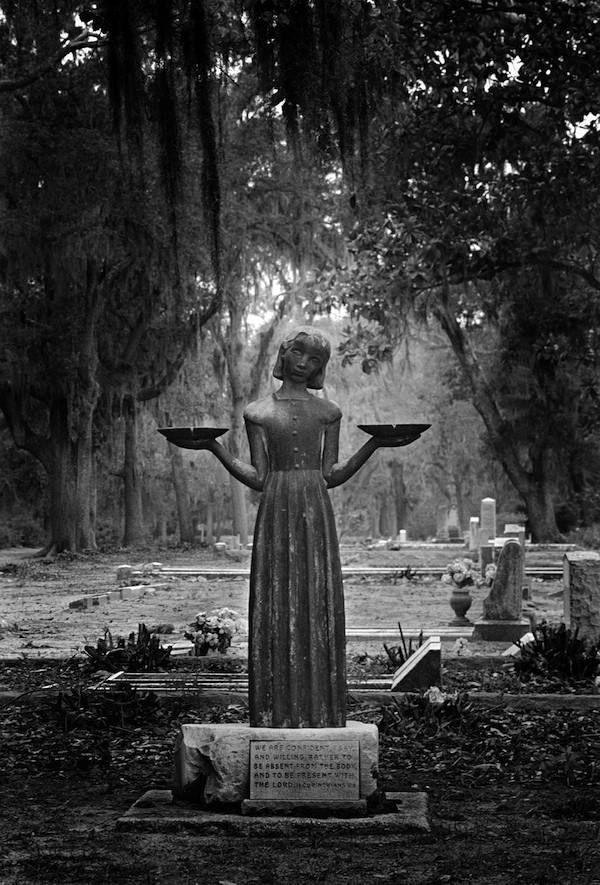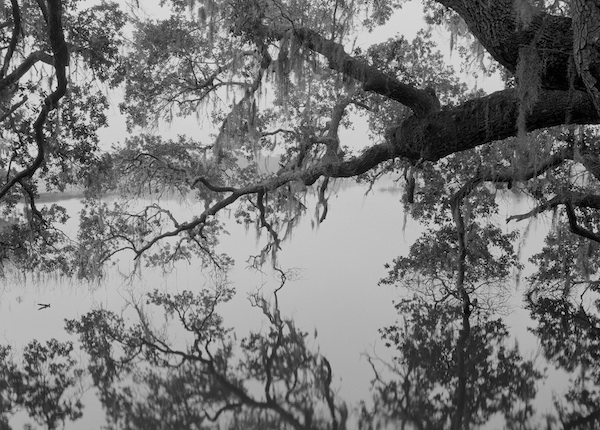Art & Exhibitions
SCAD Honors Savannah’s Own Jack Leigh with Retrospective
Photographer's impressive oeuvre goes far beyond the cover of that famous novel.
Photographer's impressive oeuvre goes far beyond the cover of that famous novel.
Jack Leigh’s work is ubiquitous in Savannah. Or, rather, one of his works in particular is on view in every other downtown shop window. You may not recognize his name, but you will almost certainly recognize Midnight, his 1993 photograph for the cover of John Berendt’s novel Midnight in the Garden of Good and Evil—or “the book,” as locals refer to it, because no other has been quite so impactful. It has become a kind of mascot for the rebirth of Savannah, so much so that the 1936 Sylvia Shaw Judson sculpture Leigh photographed in Bonaventure Cemetery had to be relocated because too many tourists were trampling the Trosdal family’s plot. Leigh never reached such a wide audience, though he was well-known in Georgia and throughout the South until his sudden death in 2004 at age 55. The SCAD Museum of Art’s new retrospective, “Jack Leigh: Full Circle, Low Country Photographs, 1972–2004,” aims to give a fuller sense of his incredible formal skills, his ease with a broad range of subjects, and his driving need to document quickly-disappearing ways of life in the region where he was born and spent most of his life.
The exhibition is modest, with some 70 images by Leigh (nearly all of them black-and-white), but it will come as a major revelation for most viewers, one that is begging to travel and be documented in a catalogue—neither of which is currently planned, sadly. It features choice works from the series Leigh shot in and around Savannah, as well as ephemera like contact sheets and maps, pieces by artists Leigh was friends with, influenced by, or who’ve been influenced by him, like Helen Levitt, Jill Freedman, and Sally Mann, and, naturally, a nook devoted to Midnight, complete with the original image, a printing template, an unaltered print, and a 1996 CBS interview. Co-curators Susan Laney, the longtime director of Leigh’s Savannah gallery, and Tim Peterson, the SCAD Museum of Art’s chief curator of exhibitions, chose the title “Full Circle” because, as a young photographer, Leigh had felt compelled to move to New York City, yet it wasn’t until he came home to Savannah that he found his voice.

Jack Leigh, Midnight (1993).
Photo: Courtesy of the Jack Leigh Estate.
Leigh’s knack for finding unique and picturesque locales in the so-called Low Country region of coastal Georgia and South Carolina is startling. More impressive still is his empathy for these places and people. His images are indelibly the work of a local, not a detached traveler.
A personal favorite of mine is one of the exhibition’s earliest works, 1971’s Farm Family on Porch, in which a family of eight poses outside its home. One of the daughters, the only person not wearing white, stands dead center, looking right into Leigh’s lens as she awkwardly tries to conceal the package of toilet paper clutched in her right hand. To the girl’s left, her mother, seen in profile, looks on proudly, the young baby in her arms suggesting she’s middle-aged while her face resembles that of an 80-year-old. This casual family portrait, neither flattering nor condescending, seems imbued with the stories of generations.
The same can be said for so many of Leigh’s photos, which lend an aura of timelessness to his documentary subject matter. His series devoted to industry are especially remarkable, from the cropped, Charles Sheeler–like images he made of modern shipping vessels and infrastructure—like Longshoreman Signaling (1979), Aboard Ship (undated), or Converging Tracks (1985)—to the photos he took tracking the otherworldly, seemingly ancient activities of local oystermen. Oysterman Sculling at Night (1981) is uniquely startling, capturing fishermen aboard two torchlit rowboats piled high with oysters surrounded by pitch black night. This haunting image of a fast-disappearing way of making a living also calls to mind Charon, the ferryman on the river Styx. As with many of Leigh’s best images, his very modern style and sensibility are the only way to be sure you’re not looking at photos from the Depression or the 19th century.

Jack Leigh, Oak Limb Reflection (2002).
Photo: Courtesy of the Jack Leigh Estate.
His series devoted to the rural poor, the marine industry, and Georgia’s coastal landscape may be Leigh’s most captivating, but Laney and Peterson have wisely included his more spare, still life–like interiors. Restful, light-filled works like Light Bulb (1979) and Two Beds, Two Windows (1981) feel worlds removed from the grueling shrimping and oystering industries Leigh was documenting those same years. Their hanging bulb and sheets, or the shirt slung over the doorknob in Nancy’s Shirt (1978), are domestic equivalents of the drooping trees and Spanish moss in works like Paddle-Boat Fishing: Carson Cross and Cecil Joiner, Burke Country (1984), Leaning Oak in Fog (2002), and countless other photos on view. They all convey a lived-in quietude, a sense that life and work in rural and small-town Georgia was hard, but also hard to leave. As Leigh experienced firsthand, and conveys so wonderfully throughout this exhibition, the Low Country has more than enough color, drama, and peculiarities to sustain a lifetime’s work.
“Jack Leigh: Full Circle, Low Country Photographs, 1972–2004” continues at the SCAD Museum of Art through October 2.